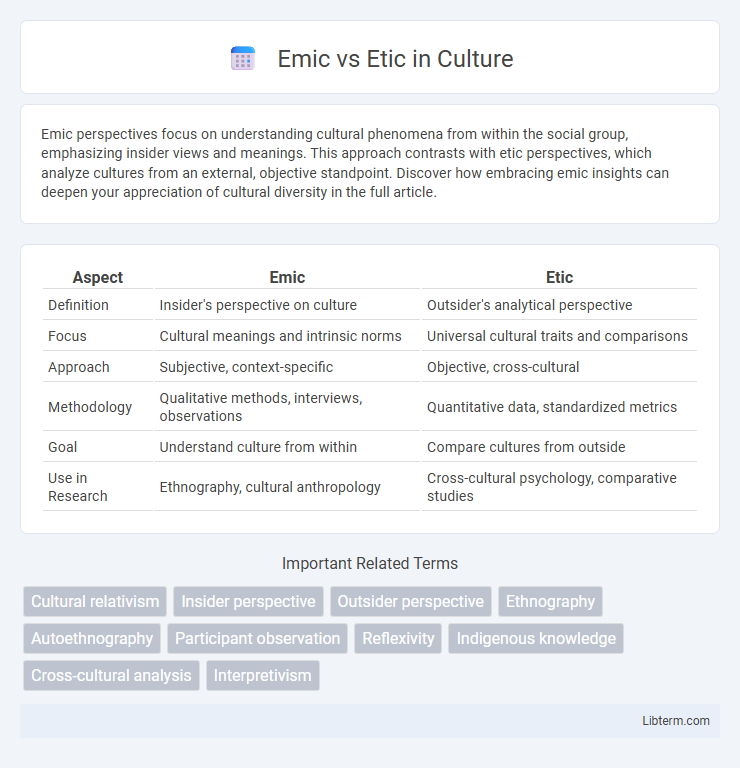Emic perspectives focus on understanding cultural phenomena from within the social group, emphasizing insider views and meanings. This approach contrasts with etic perspectives, which analyze cultures from an external, objective standpoint. Discover how embracing emic insights can deepen your appreciation of cultural diversity in the full article.
Table of Comparison
| Aspect | Emic | Etic |
|---|---|---|
| Definition | Insider's perspective on culture | Outsider's analytical perspective |
| Focus | Cultural meanings and intrinsic norms | Universal cultural traits and comparisons |
| Approach | Subjective, context-specific | Objective, cross-cultural |
| Methodology | Qualitative methods, interviews, observations | Quantitative data, standardized metrics |
| Goal | Understand culture from within | Compare cultures from outside |
| Use in Research | Ethnography, cultural anthropology | Cross-cultural psychology, comparative studies |
Introduction to Emic and Etic Perspectives
Emic and etic perspectives represent two fundamental approaches in cultural anthropology and social research, where the emic approach seeks to understand behaviors and beliefs from within the cultural context, capturing insider viewpoints and meanings. In contrast, the etic perspective analyzes cultural phenomena from an external, objective standpoint, often using standardized categories and concepts applicable across cultures. Emic insights provide depth and nuance to cultural understanding, while etic analysis facilitates cross-cultural comparison and generalization.
Defining Emic: Insider’s View
Emic perspective prioritizes the insider's view, capturing behaviors, beliefs, and cultural meanings as understood by members within a specific community. This approach enables researchers to interpret social phenomena through the native lens, emphasizing context-driven, subjective experiences unique to that culture. Emic analysis is crucial in anthropology and ethnography for generating authentic, culturally grounded insights.
Understanding Etic: Outsider’s Perspective
The etic perspective examines cultural phenomena from an outsider's viewpoint, emphasizing objective analysis and cross-cultural comparisons. It prioritizes universal concepts and seeks to identify commonalities across diverse cultures through standardized criteria. Researchers employing the etic approach utilize external categories to interpret behaviors, enabling a broader understanding beyond individual cultural contexts.
Key Differences Between Emic and Etic Approaches
Emic approaches prioritize understanding cultural phenomena from within the cultural context, emphasizing participants' perspectives and intrinsic meanings. Etic approaches analyze cultures from an external viewpoint, applying universal criteria and comparative frameworks across different societies. The key differences lie in emic's insider focus versus etic's outsider perspective, with emic highlighting subjective cultural meanings and etic seeking objective, cross-cultural generalizations.
Importance of Emic Perspective in Cultural Research
The emic perspective in cultural research prioritizes understanding behaviors and beliefs from within the culture, revealing unique meanings and practices that external analyses might overlook. Emphasizing emic data allows researchers to capture authentic insider viewpoints, enhancing the accuracy and depth of ethnographic studies. This insider approach fosters cultural sensitivity and reduces ethnocentric bias, making it crucial for valid and respectful representation of diverse societies.
Advantages of the Etic Approach
The etic approach offers the advantage of providing a standardized framework for cross-cultural comparison, enabling researchers to identify universal patterns and generalizations. This method facilitates objective analysis by using external criteria independent of the studied culture's subjective perspectives. Employing an etic perspective enhances the replicability and reliability of findings across diverse cultural contexts.
Challenges and Limitations of Emic and Etic Methods
Emic methods face challenges such as cultural bias and subjectivity, limiting generalizability beyond the specific group studied. Etic methods often struggle with ethnocentrism and may overlook nuanced cultural meanings, leading to inaccurate or incomplete interpretations. Both approaches require careful balancing to ensure valid and reliable cross-cultural research outcomes.
Applications of Emic and Etic in Anthropology
Emic approaches in anthropology prioritize understanding cultural phenomena from the insider's perspective, making them invaluable for in-depth ethnographic studies and capturing the meanings and motivations of community members. Etic approaches offer an outsider's analytical framework, facilitating cross-cultural comparisons and the application of universal scientific methods to identify broader patterns across societies. Combining emic and etic perspectives enhances anthropological research by integrating subjective cultural insights with objective, cross-cultural analysis.
Integrating Emic and Etic in Cross-Cultural Studies
Integrating emic and etic perspectives in cross-cultural studies enhances the depth and accuracy of cultural analysis by combining insider viewpoints with outsider observations. Emic approaches focus on understanding behavior and beliefs from within the cultural context, while etic methods apply universal categories to compare across cultures. Employing both frameworks helps researchers avoid ethnocentrism and develop comprehensive insights into cultural diversity and commonalities.
Conclusion: Choosing the Right Perspective
Selecting between the emic and etic perspectives depends on research goals, cultural context, and desired depth of understanding. Emic approaches prioritize insider views and cultural specificity, enhancing authenticity and nuanced interpretation. Etic perspectives enable cross-cultural comparisons and generalizations, providing broader analytical frameworks for diverse populations.
Emic Infographic

 libterm.com
libterm.com